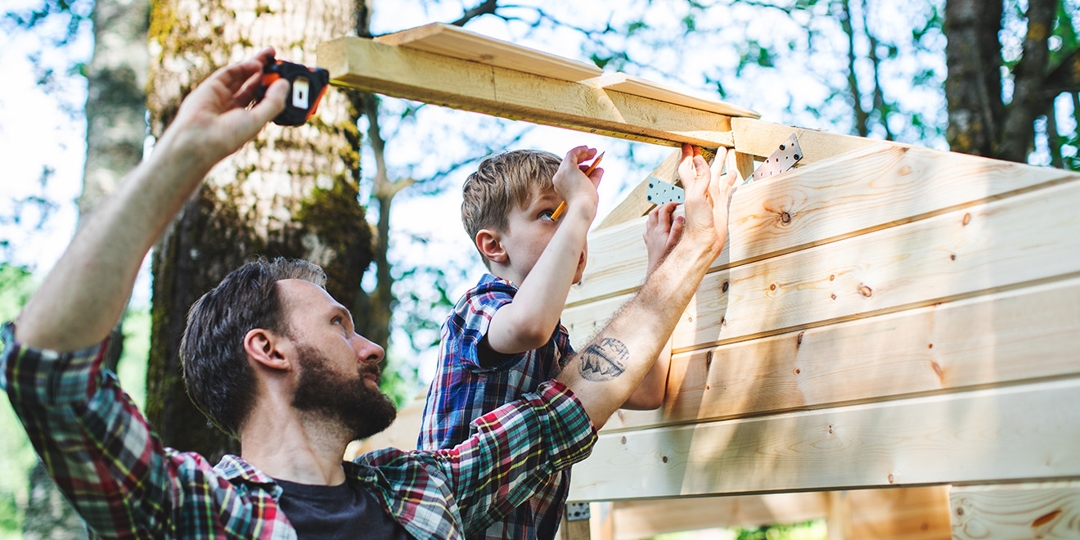Treehouses are a place of childhood nostalgia. If you want to recapture that feeling for your kids, but you don’t want to hurt the tree, what’s next? Does fastening boards and supports to your tree hurt it?
Learn more about how a treehouse could damage your tree and the best practices for building a treehouse without harm.
Do Treehouses Hurt Trees?
Yes, they can. Treehouses constructed without caring forethought can damage live tissue and open it to attack from pests and diseases. Even the normal attachment bolts you need for a secure structure can cause minor wounds. The more wounds your tree has, the more likely it is to get sick.
Further, some treehouse builders remove healthy limbs to make more room for a structure. This can shock the tree and leave it vulnerable to disease.
Working with and around your tree can minimize damage and be a win-win-win for your tree, your fort, and your yard.
Choosing the Best Tree for Your Treehouse
Now that you’ve decided to build a treehouse, it’s time to choose your tree! Look for a large, sturdy tree that doesn’t lean and has no cracks in the trunk. If you’re looking to build a large treehouse, make sure to pick a dense hardwood that can support more weight.
Choose a mature tree that’s at least 15-30 years old and avoid dwarf or shrub species and tree species that have short lifespans. We recommend maples, hickories, paw-paws, Douglas firs, boxelders, western red cedars, sycamores, ash trees, cherry trees, and oaks.
Our tree health care specialists can inspect your trees and help you avoid ones that are sick or infested for your treehouse. (And we can treat any sick trees we do find.)
Can You Build a Treehouse in a Pine Tree?
Pine trees aren’t ideal for treehouses. Most don’t have the thick limbs that can support a treehouse structure, and summertime sap can leave the whole thing a sticky mess. Deciduous trees are our preferred treehouse supports.
How to Attach a Treehouse to a Tree Securely While Minimizing Harm
Once you’re ready to get started, keep these steps in mind as you build your treehouse:
- Minimize damage. Use a tree attachment bolt to bear most of the structure’s weight. Also called a treehouse attachment bolt or a TAB, these bolts can bear thousands of pounds, usually between eight and 13,000. They also allow you to penetrate the trunk of your tree the fewest times while still providing strong, stable support.
- Save the nails for the boards. Using tons of regular nails or screws to attach parts to the tree means opening dozens of tiny wounds that your tree has to heal. Instead, only use screws and nails on your construction materials.
- Pick a big, sturdy tree. This may seem obvious, but the bigger and heavier you want your structure, the larger and sturdier the tree needs to be.
- Use non-rusting materials. This is a good rule of thumb for all outdoor structures, but any metal attachments that go into your tree should be rust-free. Your tree can heal around intrusions, so if any attachments rust away and need to be replaced down the road, it will have to heal all over again. Galvanized steel is an excellent, rust-resistant material for attachments.
- Build with future growth in mind. Trees never stop growing, and your treehouse could be in the way if you’re not careful. Note the direction that limbs and branches are growing and build around them instead of cutting them off.
- Affix rope to your structure only. If you’ve got the traditional rope ladder or pulleys to haul goodies up and down, tie them off on constructed material. Ropes tied around the trunk or tree limbs can start cutting in as the tree grows or rub away bark with friction. You should also use bolts to attach your treehouse, not ropes: they’re sturdier and cause less damage over time. Ropes can rub off bark or interfere with growth. Meanwhile, bolts cause relatively minor, concentrated intrusions.
- Balance your structure. A tree will accommodate new weight distribution over a few years, growing roots to anchor itself more securely against leaning. However, it’s best to build your treehouse so that as much of the weight as possible is driving down straight through the trunk. Otherwise, an unbalanced tree will be more vulnerable to storm damage.
How to Build a Treehouse without a Tree
Don’t have a suitable tree or just want to skip the chance of damage altogether? Don’t worry, you can still get the tree house experience!
You can build a “tree” house on a raised platform supported by deeply sunk poles. The upside is that you can build a platform treehouse as large and complicated as you want. You can let your imagination run wild when not bound to the confines of one tree.
Call Us for the Perfect Start to Your Tree Fort Project
The expert arborists at Monster Tree Service can perform a tree inspection to help you pick the sturdiest, best tree for your new project! We can recommend the best way to attach it without harming the tree and provide lifetime care to keep your tree strong for the treehouse you build.
To get started on the treehouse of your dreams, call us at (888) 744-0155 for expert advice or request a free, no-obligation estimate online today.

